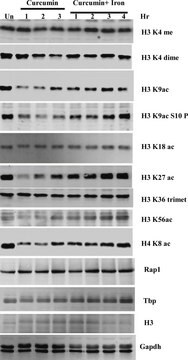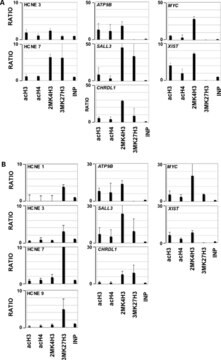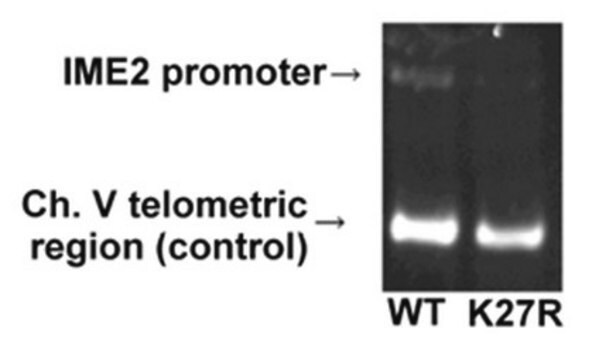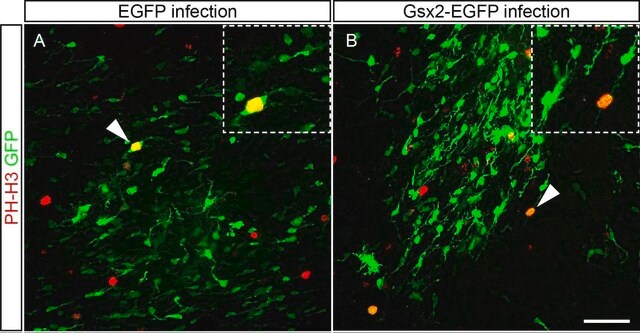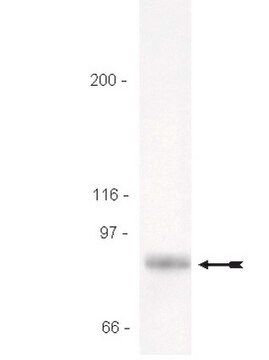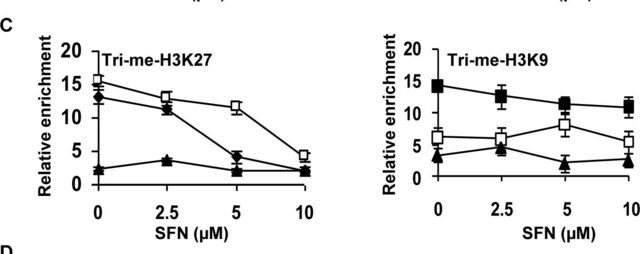07-081
Anti-phospho (Ser10)-acetyl (Lys14)-Histone H3 Antibody
Upstate®, from rabbit
Sinonimo/i:
H3K14me3S10P, Histone H3 (acetyl K14, phospho S10), H3 histone family, member T, histone 3, H3, histone cluster 3, H3
About This Item
Prodotti consigliati
Origine biologica
rabbit
Livello qualitativo
Forma dell’anticorpo
affinity purified immunoglobulin
Tipo di anticorpo
primary antibodies
Clone
polyclonal
Purificato mediante
affinity chromatography
Reattività contro le specie
eukaryotes, mouse, human
Produttore/marchio commerciale
Upstate®
tecniche
ChIP: suitable (ChIP-seq)
immunocytochemistry: suitable
western blot: suitable
Isotipo
IgG
N° accesso NCBI
N° accesso UniProt
Condizioni di spedizione
dry ice
modifica post-traduzionali bersaglio
phosphorylation (pSer10), acetylation (Lys14)
Informazioni sul gene
human ... HIST1H3F(8968)
Descrizione generale
Specificità
Immunogeno
Applicazioni
Epigenetics & Nuclear Function
Histones
1:2000-1:10,000 dilutions of a previous lot detected phosphorylated and acetylated histone H3 in acid extracted proteins from serum starved mouse 10T1/2 cells treated with 50ng/ml EGF for 12.5 minutes. Western blotting of this lot to acid extracted proteins described above was preferentially competed by peptides in the following order: phospho-acetyl-H3 (7-20) > straight chain H3 (7-20) > phospho-H3 (7-20) or acetyl-H3 (7-20).
Peptide Inhibition Analysis: A 1:500 dilution from a representative lot was used with HeLa AE for peptide block analysis.
Chromatin Immunoprecipitation:
A previous lot of this antibody was reported by an independent laboratory to immunoprecipitate chromatin. (Cheung, P., 2000.)
Immunocytochemistry:
A previous lot of this antibody detected phosphorylated and acetylated histone H3 in EGF-stimulated cells; as reported by an independent laboratory. (Cheung, P., 2000.)
Qualità
Western Blot Analysis:
1:500 dilution of this lot detected phospho acetyl Histone H3 on 10 μg of HeLa acid extract.
Descrizione del bersaglio
Stato fisico
Stoccaggio e stabilità
Handling Recommendations: Upon first thaw, and prior to removing the cap, centrifuge the vial and gently mix the solution. Aliquot into microcentrifuge tubes and store at -20°C. Avoid repeated freeze/thaw cycles, which may damage IgG and affect product performance. Note: Variabillity in freezer temperatures below -20°C may cause glycerol containing solutions to become frozen during storage.
Risultati analitici
Acid-extracted proteins from serum-starved 10T1/2 cells.
Altre note
Note legali
Esclusione di responsabilità
Non trovi il prodotto giusto?
Prova il nostro Motore di ricerca dei prodotti.
Codice della classe di stoccaggio
10 - Combustible liquids
Classe di pericolosità dell'acqua (WGK)
WGK 1
Certificati d'analisi (COA)
Cerca il Certificati d'analisi (COA) digitando il numero di lotto/batch corrispondente. I numeri di lotto o di batch sono stampati sull'etichetta dei prodotti dopo la parola ‘Lotto’ o ‘Batch’.
Possiedi già questo prodotto?
I documenti relativi ai prodotti acquistati recentemente sono disponibili nell’Archivio dei documenti.
Il team dei nostri ricercatori vanta grande esperienza in tutte le aree della ricerca quali Life Science, scienza dei materiali, sintesi chimica, cromatografia, discipline analitiche, ecc..
Contatta l'Assistenza Tecnica.

